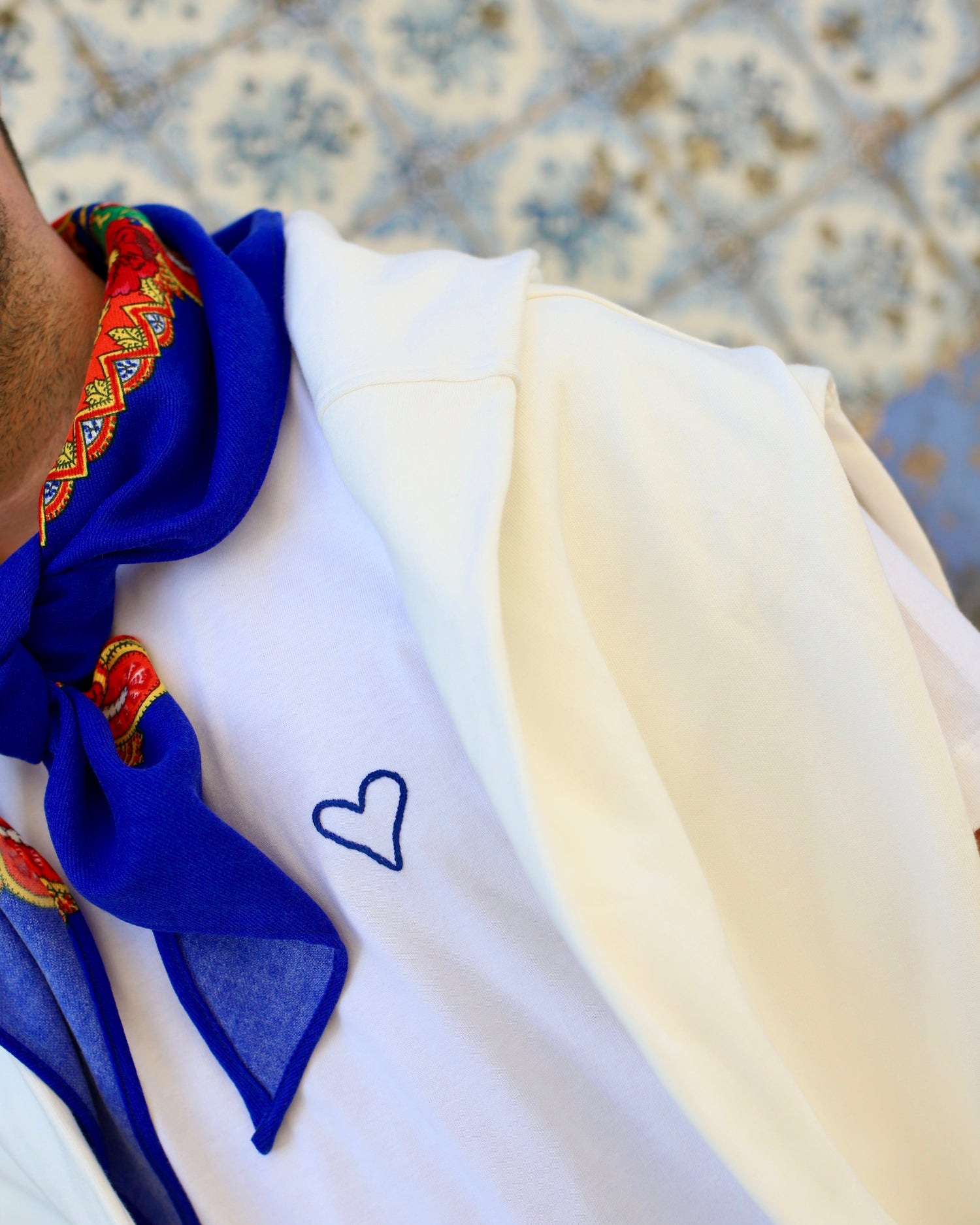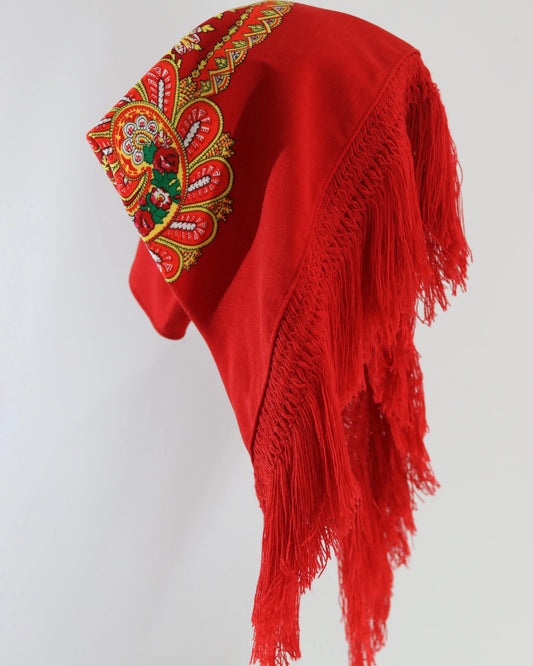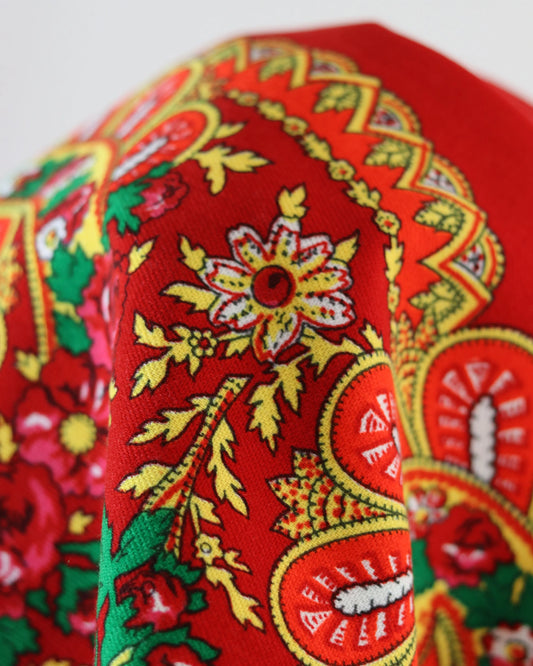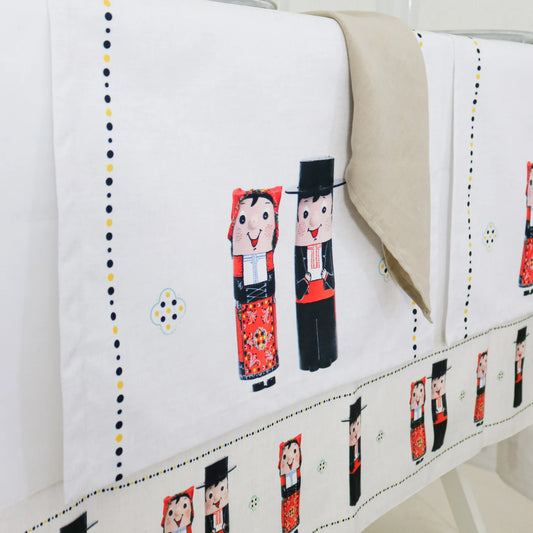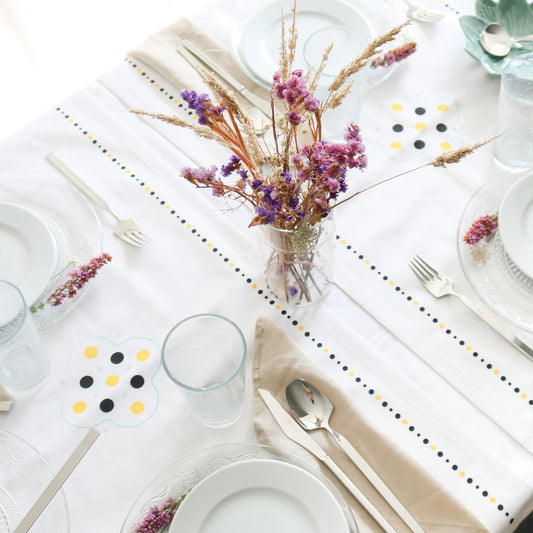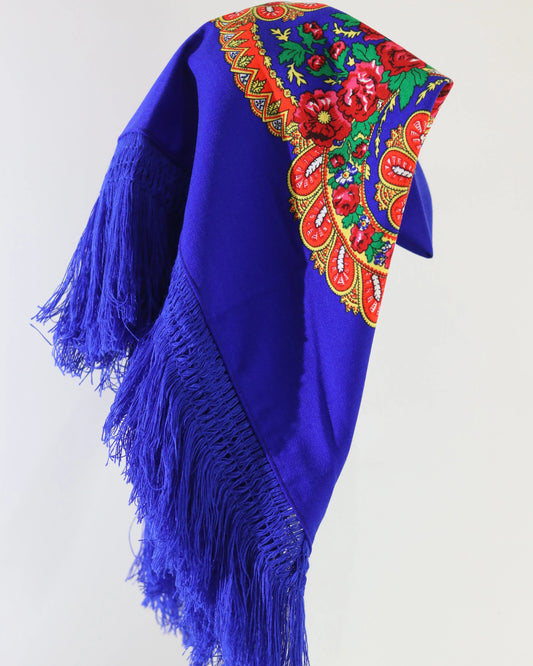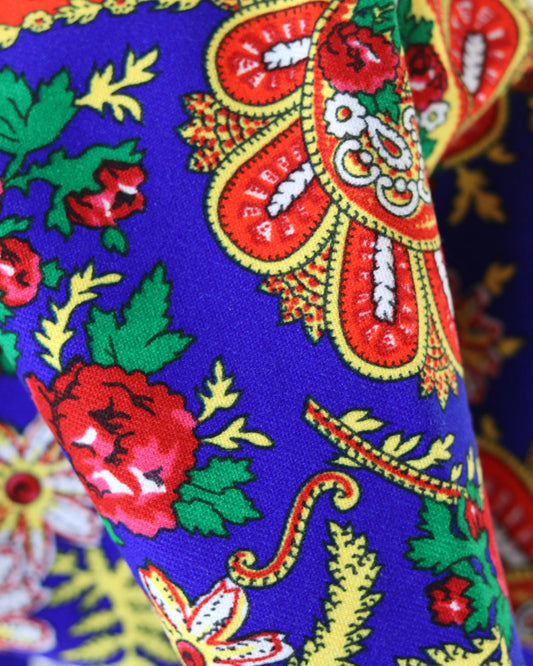Where to buy Viana's scarf: essential tips
Viana's scarves preserve memories, new interpretations of tradition, and a gesture of affection that never goes out of style. Whoever buys one takes home a piece that speaks to the past and has a place in the present: around the neck, in the hair, framed on the wall, or given as a promise of love.
The question, however, is less romantic and more practical: where can I buy a good Viana scarf with confidence, without falling into traps, and at a fair price? Let's break it down.
What makes a truly special Viana scarf stand out?
There are details that tell a story without words. A handkerchief with a balanced design, vivid floral motifs, hearts, birds, and ears of corn, phrases embroidered with ancient tenderness. The right fabric, the feel of the fiber, the restrained brilliance of the colors. And, above all, the human hand in the embroidery.
- Hand embroidery: slight irregularities, breathable stitches. It's a sign of life, not a defect.
- Traditional design: balance between solids and spaces, well-distributed motifs.
- Fine fabrics: linen and cotton are the most classic base; some ateliers work with silk and fine blends.
- Visible history: labels, embroiderer's signature, reference to local cooperatives or workshops.
Each piece is a conversation between the embroiderer and the wearer.
How to verify authenticity and quality without being an expert
You don't need a magnifying glass, but some method helps.
- Check the back: Hand embroidery has a clean back, albeit with small knots or thread changes. Industrial embroidery tends to be very neat and flat.
- Look for a label of origin: many workshops include identification, contact information, and sometimes an internal registration number. Cooperatives and museum shops provide more formal proof.
- Feel the fabric: linen and cotton have body and breathability. Cheap synthetic fabrics are too shiny and lose their shape over time.
- Ask for macro photos online: a good seller won't hesitate to show details of stitches, contours, and back.
- Compare motifs: Traditional iconography is not clipart. Mechanical repetitions and perfect patterns often indicate printing or machine printing.
Buy in person: the best of both worlds
Viana do Castelo offers the perfect setting for leisurely shopping, viewing, touching, and chatting with those familiar with the region's rich tradition. In the historic center, craft shops and embroidery workshops open their doors with patience and knowledge. Entering, asking questions, and learning is part of the experience.
- Workshops: where you can see the frame assembled and the design emerging stitch by stitch. Ideal for customizing and ordering.
- Cooperatives and associations: These aggregate the work of several embroiderers, control standards, and help maintain techniques. They usually have good documentation of origin.
- Museum shops: The Costume Museum is a local landmark. The shop typically features curated items of consistent quality.
- Fairs and events: During the summer and festive seasons, the selection grows, and the entire city breathes embroidery. This is a great way to compare styles and prices in just a few hours.
A simple tip: ask who embroidered it, how long it took, and what stitches were used. A reliable answer is worth its weight in gold.
Buy online with confidence and without complications
The internet has opened doors for village workshops and independent embroiderers. Buying remotely is possible and can be an excellent decision, as long as you choose wisely.
Quick checklist for online:
- Own page or cooperative store with clear contact details
- Detailed photographs, including reverse side
- Transparent return policy
- Realistic production and shipping times
- Possibility of customization with approved sketches
- Invoices and receipts issued without hassle
Warning signs:
- Very low prices for complex hand embroidery
- Vague or contradictory descriptions
- Images always the same in different ads
- Rush to close the deal without answering questions
Craft platforms and social media can connect you directly with artisans. Chat, request examples of their work, and ask how they care for their fabric. This conversation is already half the purchase.
Personalization: initials, phrases and colors to your taste
A personalized Viana scarf is worth it for its symbolism. Discreet initials in the corner, a special date, a traditional or new phrase written with aesthetics in mind. In workshops, the design is studied on tracing paper, adjusted in the hoop, and confirmed before embroidery.
Points to consider:
- Typography: Cursive letters combine well with floral motifs
- Colors: The traditional palette uses red, blue, green, and yellow; orders outside this palette require a balance test.
- Time: High-density text embroidery takes weeks, not days.
- Proofs: ask for drafts and confirm the text placement to avoid surprises
How much does it cost and what influences the price?
A fair price supports the technique and ensures that each point is worth the time spent. The final price is determined by several variables:
- Scarf size
- Embroidery density and number of colors
- Fabric type and yarn quality
- Degree of customization
- Reputation of the workshop or embroiderer
- Certification and documentation
Hand-embroidered pieces, with dense designs and fine linen fabric, naturally fall into a higher price range. Entry-level pieces, with lighter motifs and cotton fabric, make tradition accessible.
Materials, sizes and ways of using
There's no single rule. What exists is adaptation to usage and regional preference.
Most common materials:
- Linen: classic, durable, drapes well and gains beauty over time
- Cotton: softer, great for everyday wear
- Silk: delicate shine, ideal for special occasions
- Blends: balance feel, price and durability
Sizes and uses:
- Small: neck, wrist, bag strap
- Medium: hair, shoulders, waist
- Large: costume, ceremonial, wall centerpiece
Coordination ideas:
- With a white shirt and blue blazer
- About high neck knit in neutral tones
- With a simple dress, highlighting the scarf as the protagonist
- Framed with clear mat, UV protected glass
Care that makes a scarf last for decades
Maintaining color brightness and stitch firmness requires attention. Proper care is simple.
- Hand wash, cold water, mild detergent
- Do not wring; remove excess water with a towel.
- Dry horizontally, in the shade.
- Iron inside out with a warm iron and a thin cloth between the iron and the fabric.
- Store flat or rolled in tissue paper, away from direct light.
- Avoid hangers that deform the item.
Spot stains require gentle compresses. Harsh products break down the fiber and fade the color.
Shopping channel comparison tool
| Channel | Strengths | Attention to be paid | Expected price | Personalization | Confirmation of origin |
|---|---|---|---|---|---|
| Local workshop/studio | Speak directly to the embroiderer; see the reverse side | Longer deadlines during high season | Medium to high | High | High |
| Cooperative/museum store | Curation and documentation | Less broad selection by author | Medium to high | Average | Very high |
| Craft shops | Variety and immediate comparison | Variable quality between suppliers | Variable | Average | Average |
| Fairs and pilgrimages | Rich offer and competitive prices | Difficult to decide in the middle of attendance | Variable | Average | Medium to high |
| Artisan's online store | Access to reference works | Requires validation by photos and reports | Medium to high | High | High |
| Marketplaces | Options in various ranges | Risk of print sold as embroidery | Low to medium | Low to medium | Low to medium |
Frequently asked questions to help you decide better
- Hand or machine embroidery? If you're looking for tradition, choose manual. Machines can complement production, but they don't replace the expression of hand-stitching.
- Raw or colored fabric? Raw enhances the design and stands the test of time. Bright colors work well, but require careful handling and careful washing.
- Can it be used on a daily basis? Yes. Opt for medium-weight cotton or linen, lighter designs, and colors that match your base clothing.
- How long does an order take? From a few days to several weeks, depending on density, production queue, and customization. Plan ahead for special dates.
- How do I buy a gift without making a mistake? Choose classic motifs, balanced colors, and a medium size. Ask for thoughtful packaging and cardboard with a story behind the scarf.
Practical steps for a safe purchase
- Define the main use: dressing, gifting, decorating.
- Choose material and size according to this use.
- Decide between a ready-made piece or a custom order.
- Research three suppliers, compare inside-out photos and sales policies.
- Confirm delivery times and shipping methods. Insurance for valuable items is welcome.
- Save receipts and labels. Tell the story when you offer it.
Tips for those visiting Viana do Castelo
The city thinks and lives its own costumes. It's worth taking the time to calmly observe, ask questions, and learn techniques.
- Attend workshops with exposed backstage. Ask about the stitches, the inspiration behind the motifs, and the execution time.
- Visit exhibition spaces that contextualize regional costumes and embroidery. Understanding the pieces gives them a new dimension.
- During the holidays, the selection increases dramatically. Arrive early, as the best pieces may sell out quickly.
- Combine shopping with local cuisine. Dinnertime conversations reveal stories and point you to great places.
Also bring photos of the clothes you want to wear the scarf with. Experienced salespeople appreciate helping you fine-tune colors and scales.
How to avoid printed replicas disguised as embroidery
The fast-paced market has created shortcuts. Recognizing a fake avoids regrets.
- Flat surface without wire relief indicates stamping
- Perfect repetition of a design across multiple stores is a sign of an industrial matrix
- Very low prices for dense patterns do not match the time the hand requires
- A completely clean and smooth reverse is usually printing, not embroidery.
If you're looking for an affordable graphic accessory, printing is a good option. If you're looking for a living tradition, pass it on.
Keeping your budget in check without missing the right part
The best purchase isn't always the most expensive. It's the one that combines authenticity, suitability for use, and fair compensation for work.
- Establish a comfortable range
- Prioritize material and good design before adding customizations
- Prefer parts with minimal documentation
- If you really like a dense subject, consider a smaller size.
- Buy less often, better
Ask the seller for an explanation of the price: estimated hours, type of fabric, and threads used. Transparency is a good sign.
Gift with history
A Viana scarf has the rare ability to speak for the giver. It's an engagement and anniversary gift, a baby's arrival, a thank you to a godmother, or a graduation milestone. The gesture remains.
Ideas to make the gift memorable:
- Short phrase embroidered in a corner, in small print
- Fabric envelope with the person's name
- Small leaflet explaining the design and precautions
- Simple framing, if the use is decorative
The recipient understands when there was time and intention behind the choice.
Suggested half-day shopping itinerary
- Morning: visit to an exhibition space to absorb references, followed by a workshop where you can see behind the scenes.
- Coffee and notes: select two or three stores with pieces that stuck with you.
- Short afternoon: return to your favorite piece, confirm the reverse and finish, discuss possible customization and close the purchase.
- Before leaving: check adequate packaging, contacts for future maintenance and written care instructions.
Between each step, leave room for the unexpected good: a conversation with an embroiderer, a motif that surprises you, a color you didn't expect to use. This is how a scarf finds its person.



